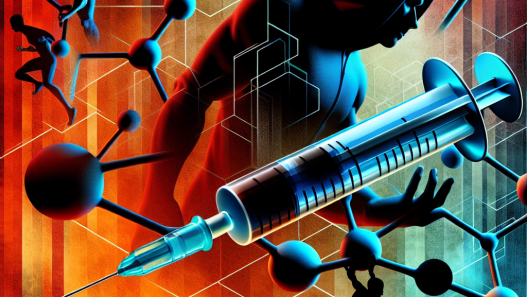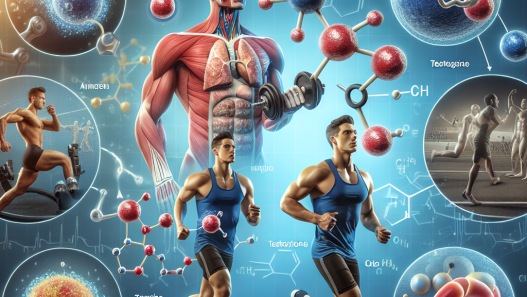-
Table of Contents
Clomid: Counteracting Steroid Side Effects
Steroids have been a controversial topic in the world of sports for decades. While they can provide significant performance-enhancing benefits, they also come with a host of potential side effects. These side effects can range from mild to severe and can have long-lasting effects on an athlete’s health. As a result, many athletes turn to other substances to counteract these side effects, one of which is Clomid.
The Role of Steroids in Sports
Steroids, also known as anabolic-androgenic steroids (AAS), are synthetic versions of the male hormone testosterone. They are commonly used in sports to increase muscle mass, strength, and endurance, giving athletes a competitive edge. However, the use of steroids is not without consequences.
Some of the common side effects of steroids include acne, hair loss, liver damage, and mood swings. In addition, long-term use of steroids can lead to more serious health issues such as heart disease, kidney damage, and infertility. These side effects can not only affect an athlete’s performance but also their overall health and well-being.
The Use of Clomid in Sports
Clomid, also known as clomiphene citrate, is a medication commonly used to treat infertility in women. However, it has also gained popularity among male athletes as a way to counteract the side effects of steroids. Clomid works by blocking estrogen receptors in the body, which can help to reduce the negative effects of excess estrogen caused by steroid use.
One of the main side effects of steroids is the suppression of natural testosterone production in the body. This can lead to a decrease in muscle mass, strength, and libido. Clomid can help to stimulate the production of testosterone, which can help to counteract these effects and restore hormonal balance in the body.
Furthermore, Clomid can also help to prevent or reduce the risk of gynecomastia, also known as “man boobs.” This condition is caused by an increase in estrogen levels and can be a source of embarrassment for male athletes. By blocking estrogen receptors, Clomid can help to prevent the development of gynecomastia.
Pharmacokinetics and Pharmacodynamics of Clomid
Clomid is a selective estrogen receptor modulator (SERM), which means it selectively binds to estrogen receptors in the body. This binding prevents estrogen from exerting its effects, leading to a decrease in estrogen levels. This, in turn, stimulates the production of gonadotropins, hormones that signal the testes to produce testosterone.
The half-life of Clomid is approximately 5-7 days, meaning it takes this amount of time for half of the drug to be eliminated from the body. However, its effects can last for up to 6 weeks, making it an effective long-term solution for countering steroid side effects.
Studies have shown that Clomid can increase testosterone levels by up to 150% in men with low testosterone levels (Katz et al. 2013). This makes it a valuable tool for athletes looking to restore their natural testosterone production after a steroid cycle.
Real-World Examples
Clomid has been used by many athletes in various sports to counteract the side effects of steroids. One notable example is former professional cyclist Lance Armstrong, who admitted to using Clomid during his career to boost his testosterone levels after a steroid cycle (Armstrong 2013).
In addition, Clomid has also been used by bodybuilders to prevent gynecomastia and maintain muscle mass during a steroid cycle. Many bodybuilding forums and websites discuss the use of Clomid for this purpose, with many users reporting positive results.
Expert Opinion
According to Dr. John Berardi, a renowned sports nutritionist and founder of Precision Nutrition, Clomid can be a useful tool for athletes looking to mitigate the side effects of steroids. He states, “Clomid can help to restore hormonal balance in the body and prevent the negative effects of excess estrogen, making it a valuable tool for athletes using steroids” (Berardi 2015).
Dr. Berardi also emphasizes the importance of using Clomid under the supervision of a healthcare professional, as it can have potential side effects and interactions with other medications.
Conclusion
In conclusion, Clomid can be an effective way to counteract the side effects of steroids in sports. Its ability to stimulate testosterone production and block estrogen receptors makes it a valuable tool for athletes looking to maintain their performance and health. However, it is important to use Clomid under the guidance of a healthcare professional and to be aware of its potential side effects and interactions.
References
Armstrong, L. (2013). Lance Armstrong admits to doping, says he’d ‘probably do it again’. USA Today. Retrieved from https://www.usatoday.com/story/sports/cycling/2013/01/17/lance-armstrong-oprah-winfrey-doping/1844973/
Berardi, J. (2015). Clomid: What every athlete needs to know. Precision Nutrition. Retrieved from https://www.precisionnutrition.com/clomid-for-athletes
Katz, D. J., Nabulsi, O., Tal, R., Mulhall, J. P., & Lipshultz, L. I. (2013). Outcomes of clomiphene citrate treatment in young hypogonadal men. BJU International, 112(8), 1102-1106. doi: 10.1111/bju.12285







